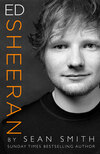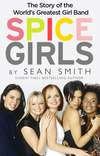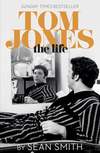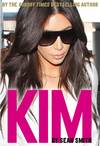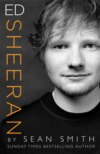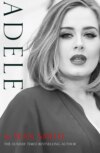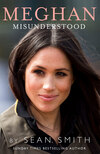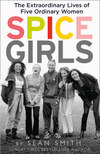Kitabı oku: «Ed Sheeran», sayfa 4
That rock sound continued on ‘Celebrity’ and ‘Sleep’, which must have been a precious commodity in the Sheeran household, with Ed on electric guitar in one room and Matthew on violin in another. ‘Mindless’ was a post-punk homage to Kentucky Fried Chicken before the album ended on a high note with ‘I Love You’, which was probably the closest track to future Ed Sheeran. The problem with his slower songs was that they exposed more obviously his vocal limitations at the time. As every musician knows, recording the album is only the start of the process. He needed a title and decided to call it Spinning Man after a late work by the great surrealist Salvador Dalí. John Sheeran had hung a print on a wall at the house so Ed was very familiar with it and the title seemed perfect for a spinning CD.
To add to the professional feel of the project, Ed enlisted his parents to help produce a proper CD, complete with case and sleeve notes, which proudly declared that all the material was copyright Ed Sheeran and Sheeran Lock Ltd. He asked Alison Newell, a local artist and family friend, to design the cover. She featured his Faith guitar to one side of a black background. Some delicate white spirals, shaped like a prawn, make simple embroidery. The back featured a photograph taken by his father of Ed playing the same guitar on the streets of Galway the previous summer, his first venture into busking. In his thanks, Ed included ‘all those who put money into my guitar case’.
He also thanked his cousins Laura and Jethro, his brother Matthew and all Sheerans and all Locks. There are thanks, too, for Mums and Dabs, his pet names for his mother and father since he was a toddler. Among the friends he acknowledges, he mentions Claire – the inspiration for some of the songs, including ‘I Love You’. According to Ed, they had a very innocent hand-holding friendship that was over by the time he recorded the album, although he was upset when they broke up.
For his musical inspiration, Ed cites Damien Rice, Eric Clapton and ‘Jimmy H’ (presumably Jimi Hendrix) but there is sketchy evidence of their influence on the album. There’s something of Hendrix and Clapton but Spinning Man bears no resemblance to Damien Rice, who really doesn’t do solos, big riffs or long instrumentals on an electric guitar. At thirteen, Ed was still searching for his own sound and his first album was really a hangover from his schoolboy band Rusty. He is, though, too modest about the achievement.
Perhaps the most interesting aspect of Spinning Man is its maturity, best exemplified by his personal message on the sleeve notes: ‘Songwriting and playing the guitar are like having a direct line to my thoughts and feelings. Everyone has strong feelings whatever their age. We can all feel love, joy, longing, pain and hate.’ His mother may have used her editing skills to help but it clearly reveals Ed’s early self-awareness.
He sent the CD to Lisa Hannigan but wished he had waited when he didn’t get a response. The reaction from those he played it to in Framlingham was very encouraging. Nobody wanted him to lose heart by being over-critical of his first recordings, particularly his mother and father. They agreed that if he wanted to make money out of his music, it had to be recorded to a higher standard than he could achieve in his bedroom. He also needed to work on his singing.
When his mum and dad realised how seriously Ed was taking his music, they asked Keith, who had been a television and radio producer, if he could find a local studio to record some of the songs to a more professional standard: ‘John said to me, “Give him some experience in a studio.”’ John was more interested in Ed spending time in a proper studio than in the finished product.
They found the ideal location just a few miles away in the town of Leiston at the renowned Summerhill School, the progressive educational facility founded by A. S. Neill. His grandson Henry Readhead ran the studio there mainly for the school but said that Ed could come with Keith for a session in March 2005.
Keith agreed to waive his fee as producer for the day in return for an hour or two in which John would show him how to improve his business online and make better connections for his own music and performance. John taught him how to build a network of links so that one gig would lead to another. Imogen told him, ‘It’s the currency of the day.’ That system of barter had served Sheeran Lock well and would continue to be useful to Ed as he sought to promote his work.
For The Orange Room, named in honour of his bedroom, they chose Ed’s five favourite tracks from Spinning Room and put them in a different order: ‘Moody Ballad of Ed’ followed by ‘Misery’, ‘Typical Average’, ‘Addicted’, finishing again with ‘I Love You’.
The most striking improvement from Spinning Man was the use of acoustic guitar and, generally, a better vocal, but his attempt at falsetto on ‘Addicted’ needed plenty of work. Occasionally, there are hints of the later Ed Sheeran. Keith remembers doing his best to convince Ed that he needed to tune his guitar all the time because it would show up on an edit even if it was just slightly out of tune: ‘He was a little bit lazy about it.’
Ed had turned fourteen and was beginning to stick up for himself musically. When Keith hinted that a vocal was just a little bit out of tune and they should go back and do it again, Ed was quite clear: ‘I like that. I want to keep that as it is.’ Henry acted as sound engineer and one of his protégées, Megumi Miyoshi, who was sixteen and a promising singer, helped with mixing and some backing vocals.
The Orange Room clearly illustrates the growing influence of Damien Rice, although ‘Typical Average’ still sounds like Green Day jamming after a heavy night out and is not remotely related to anything from O.
Ed saved up and pooled all his resources to have a thousand CDs produced, which was quite optimistic. He proudly took them to school and offered them round for a fiver. Most of them sat around in boxes at home, where they remained until he became famous. Then he had to ban his mum from selling either The Orange Room or Spinning Man.
In an interview on The Jonathan Ross Show in December 2014, Ed played a short segment of a song from his phone. It was ‘Addicted’ and sounded very average. His guitar work was good but not the vocal, which had cats running for cover. In Ed’s defence, his vocal problems were mainly because his voice had yet to break so he struggled with intonation. But as Ed accurately commented, ‘You have to learn and really practise.’
5
The Loopmeister
One evening Keith and Sally Krykant were among a group of friends invited round to John and Imogen’s house for dinner. When they arrived, Preston Reed was already sitting at the dining table. Anyone taking an interest in guitar would have known about him, a striking figure who featured often in the serious music press talking about his unique playing style.
Ed had noticed in a guitar magazine that the virtuoso player was offering places on a summer-school venture at his home in Scotland. He would be teaching his percussive method, known in the business as ‘tapping’, to a few chosen students during the summer holidays. Ed set about convincing his parents that the workshop was vital to his development as a musician.
Preston, it transpired, was playing a gig locally and the Sheerans went along. Instead of grabbing a quick autograph, they invited him to stay at the house; he accepted. Keith was particularly impressed: ‘This guy is a world-class international player, who had developed his own style of playing. It was completely different to just changing the tuning.’
Presumably John and Imogen made a deal involving the ‘currency of the day’ because, during the next summer holidays, Ed set off with his father on a train to Girvan on the Ayrshire coast for a five-day summer workshop. Preston had moved to this beautiful part of Scotland, fifty miles south of Glasgow, from his home in Minneapolis in 2001.
This was not a holiday for Ed, although he and his father managed to fit in a boat trip to Ailsa Craig, the famous granite island in the Firth of Clyde. Preston was impressed by Ed’s work ethic, unusual in one so young: ‘He was intelligent and quick; he very quickly picked up the things he had come up to learn. Even at fourteen, you could tell he had a real determination and ambition.’
The trip was made more memorable for Ed by the presence of the only other student on the trip, an amazing guitar player from Oklahoma called Jocelyn Celaya, who would develop a strong following in subsequent years as Radical Classical. Jocelyn had arrived with her boyfriend, who told everyone that he used to be a gangster in Mexico. Ed, who was enthusiastic about gangsta rap at the time, couldn’t believe he was face to face with a real one and bombarded him with questions. On the last night, everyone got together for a party and Preston played some of his own compositions including ‘Fat Boy’, ‘Metal’ and ‘Ladies Night’. Ed entertained everyone by making up rap lyrics to accompany the music. ‘He just rattled it off,’ recalled Preston. ‘It was quite funny and impressive as well.’
On his return to Framlingham, Ed was not about to become the second Preston Reed but the interlude helped him view the acoustic guitar as more than just a stringed instrument. Preston’s technical innovations showed him ‘the music you could make using the guitar as a source of sounds’. Ed absorbed that lesson from his trip to Scotland and would use it in his own way when he was introduced to an even more important character in his development as a performer.
But, first, he had to go back to school. Ed was fortunate in that it wasn’t just his mum and dad who recognised he had a special talent and could make something of his music. The director of music at Thomas Mills, Richard Hanley, realised early on that the teenager was different from his other students and needed a more thoughtful approach. Richard specialised in classical music and was more closely involved with teaching Matthew, but he followed the headmaster’s lead and gave all his students the opportunity to flourish. That was the key for Ed, who has always acknowledged the debt he owes his school.
At first, Richard was hoping to persuade Ed to follow his brother and join the school orchestra, but soon discovered he was persevering with the cello on sufferance. Ed was relieved to give it up and concentrate on the guitar. He could often be found in one of the small practice rooms in the music department working on a new song. Richard explains, ‘I think the school gave him the chance to be creative, to have the time and space to play and compose and perform.’ His passion for his music was all-consuming.
Ed was never going to match Matthew’s academic dedication. Even Imogen acknowledged that her younger son was not an exam person and struggled to apply himself to read music properly. In many ways, though, Matthew was the more eccentric of the two talented brothers. Richard acknowledges that Matthew was very creative as well as academic: ‘He had some quite avant-garde ideas.’ One Easter he composed ‘Broken Pavements’ for the school concert at St Michael’s: ‘It was a very atmospheric piece. I can still remember the sunlight pouring through the great east window at the church illuminating the players. It was a magical moment.’
As teenagers, the two Sheeran boys were totally different. They had their own groups of friends and just did their own thing. For a time, Keith Krykant taught Matthew as well: ‘He particularly wanted to know about jazz improvisations. He was very mathematical in his music and was very interested in theory. He wanted to know how the notes added up mathematically to give a certain chord.
‘He wanted to consolidate some of the things he was doing on the piano and understand how they related to the guitar. He used to compose on a computer and had a much more mechanical approach to that than Ed, who was more interested in getting a song out with a rhythm and a melody.’ In his own way, Matthew was just as ambitious as Ed: he wanted to establish himself as a classical composer. The two boys never fell out but, as Keith remembers with a smile, ‘They never used to speak to each other in the house.’
Keith was still trying to teach Ed some music theory but he was fighting a losing battle. Every week he would arrive at the house with a careful plan for the lesson with ‘Edward’ – as he always called him, just as his parents did. He explains, ‘I would decide that we would take a piece of music – pure music notation – and I would explain to him how we would get that on to a guitar. It is quite tedious. And we maybe would get five minutes into the theory and he wasn’t really interested in it. He would suddenly say, “Oh, Keith, do you want to hear a song that I wrote last night at one o’clock in the morning?” And I would say, “OK.” So he would start playing this song. And ask me, you know, “What do you think of this?” And I might suggest that he put something extra in just to bridge the chords – harmony, if you like. And if he liked it, he would light up and go, “Wow, that really works now. Keith, you’re a genius!”’
Ed was showing great maturity for his age in what he was listening to and what he wanted to play. His father’s taste had rubbed off on him. He still wanted to enjoy his favourite hip-hop artists but, post Damien Rice, he was developing more interest in singer–songwriters such as Ray LaMontagne, whose debut album, Trouble, in 2004, had showcased his distinctive vocal style, as well as all-time greats, including Paul Simon. He spent an entire lesson with Keith learning how to play the famous Simon and Garfunkel hit ‘Sound of Silence’.
‘You could see that he liked songs with strong melodies,’ observes Keith. ‘Most of the kids at the time were listening to The X Factor, which had just started, and following that, but he was appreciating other things.’
Another of Ed’s characteristics that served him well as a teenager was his lack of fear. He was appreciative but not overawed by the occasion. He took meeting Preston Reed in his stride. On another memorable occasion John and Imogen had arranged a dinner party where the guests included the local vicar. Keith and his wife were there: ‘Edward sang a ballad in the front room in front of the vicar and everybody else in a very, very confident and emotional way. It was very mature because he was only fourteen. It was extraordinary. Most of the children I teach won’t ever sing or play in front of their mum and dad. In fact they will play in front of anyone else but their mum and dad. But his mum and dad were there and he sang this song and completely held the audience – except the vicar, who can’t stand guitar music.’
The priest might not have appreciated being in the audience for a concert at the Shepherd’s Bush Empire in January 2006. The modest Sunday-night gig would change the course of Ed’s life as a performer. He and his dad had driven to London to see Nizlopi, an unconventional duo who had just had a number-one hit with their ‘JCB Song’. He was transfixed, though, by the opening act, an Irish singer–songwriter called Gary Dunne.
Gary used a Boss Loop Station and it was the first time Ed had witnessed how exciting that could be live. Gary built a song that filled the popular venue even though he was alone. He performed five numbers finishing with his ‘Amerikan Folk Song’, which Ed singled out as the track that had made him realise looping was the way forward for him to create his own individual sound. The musician plays a few bars, then has the loop station play it back while he lays another set of chords over the top. This can be done multiple times building layers of sound. In other words, you become your own band.
Gary did his best at performing the often thankless task of being a supporting act when the audience were standing around chatting and having a pint. He made a point of plugging his album, Twenty Twenty Fiction, which was on sale at the merchandise desk in the foyer. He also announced that he did house concerts, if anyone was interested.
Ed couldn’t stop talking to his dad about the loop pedal so John wrote to Gary saying, ‘My son absolutely loved what you did,’ and inviting him to Framlingham for Ed’s fifteenth-birthday party in a few weeks’ time.
‘House concerts’ were part of Gary’s musical world. They enabled him to earn extra pennies when he was between tours, further spread the word about his music and hopefully sell some CDs. He quoted John his standard deal at the time: ‘It was accommodation, a few hundred quid and a six-pack of Guinness. They were simple times.’
The week before his birthday, there was a tragic turn of events. One of his school friends, Stuart Dines, was killed in an horrific coach crash in Germany. Stuart, who was three months younger than Ed, was one of a group of pupils from Thomas Mills on a half-term trip to the Austrian ski resort of Fugen. On the autobahn near Cologne, the double-decker coach got a puncture and had to pull over onto the hard shoulder. A lorry carrying metal rods careered into the stationary vehicle.
Stuart was killed when a piece of metal from the lorry smashed through one of the coach windows.
Ed was not on the trip, but he knew Stuart well and they had been round to each other’s houses. Stuart lived in the nearby town of Woodbridge and his elder brother and sister went to school there. His parents, however, chose Thomas Mills for Stuart because he had ADHD and they felt it would better suit their son. That proved to be the case and, just like Ed, he was a happy and popular classmate and not at all an outsider. His proud father Robert recalls, ‘Stuart was very outgoing and if anyone was a bit shy, they could latch on to Stuart. He would talk to anybody. He had so much energy.’ He also shared Ed’s gift of being able to memorise complicated lyrics, which would leave his father wondering why he couldn’t do the same with his schoolwork.
The school flag was at half mast when everyone returned after half-term. The headmaster at the time, Colin Hirst, who had faced the difficult task of telling Stuart’s parents what had happened, said that the children were ‘devastated and shocked’.
Stuart’s father Robert remembers, ‘Ed was very, very upset, like a lot of the children.’
Ed had to come to terms with the death of someone he saw practically every day. He resolved to write a song about his feelings. He composed, he said, ‘whilst I got round to actually accepting it.’
The song that he eventually finished is a breathtakingly beautiful tribute to his friend called ‘We Are’. He completed it in time for Stuart’s funeral at Woodbridge Methodist Church and the CD recording was played during the service along with some of Stuart’s favourite Queen records. So many people wanted to pay their respects that they filled the church and the hall next door, into which they piped the music so that everyone could hear it. Afterwards Ed presented Robert, and Stuart’s mother Jackie, with a signed copy of the CD. ‘It is a lovely song,’ observes Robert.
Before the funeral, Ed’s fifteenth birthday party was a chance to cheer himself up, as well as his friends. Ed went to a lot of trouble setting up a PA system in the spacious living room at home and he and his dad drove off to Ipswich Station to collect Gary. This was the first time they had met him. Gary played a hugely appreciated set of his songs to ‘Ed and all his teenage buddies, who told me they loved the show’.
He stayed up late talking with John and Ed and a few of his mates. They reminisced about Ireland. Gary is from Portlaoise, fifty miles west of Dublin. His father, also called John, ran a folk club at Kavanagh’s pub, which hosted many of the musicians Ed most admired, including Andy Irvine, an original member of Planxty. Gary still has the picture of Andy, his father and a teenage Ed taken there.
Most of the country had seen a loop pedal for the first time when the Scottish singer–songwriter KT Tunstall used one to mesmerising effect on a 2004 edition of Later … with Jools Holland. She stole the show when she created a one-woman-band effect for her song ‘Black Horse and the Cherry Tree’. But Gary had first become interested in looping two years earlier when he had played at the Lobby Bar, a music pub in Cork. He was on a bill that included the acclaimed American singer–songwriter Joseph Arthur and could scarcely believe Joseph wasn’t using a backing track. Gary had marvelled at how he could make all those sounds live through a loop station. The music business is full of such chance connections. That gig in a tiny bar in Cork would lead indirectly to one of the most important ingredients in the development of the Ed Sheeran sound.
By coincidence both Gary Dunne and Damien Rice had supported Joseph Arthur at one time. Ed was thrilled to hear that Gary had also opened for Damien Rice on tour and told him about the gig at Whelan’s he had been to with his cousin Laura. Gary observes, ‘He was a hardcore Damien Rice fan back then.’
Gary found meeting the Sheeran family a ‘very warm and enjoyable’ experience: ‘In the morning Imogen cooked a big, beautiful fry-up and we went for a walk near by.’ Before he left Framlingham, Gary went through the process of looping with Ed. He showed him the Boss RC20 model he used and recommended that Ed try it. It was a simple but rugged piece of equipment that could survive being hauled around by an impatient teenager.
Ed went straight out and bought one, which cost roughly £250. Looping was not a technique you could learn overnight and it took him well over two years of constant practice to feel that he had finally mastered the pedal – he soon found that one mistake could throw a whole song out of synch. The new skill, however, did allow him to improve ‘We Are’ and turn it into a multi-layered ballad, recognisable as the one he would perform many times in the future.
Gary was happy to offer advice by phone or email and they remained on very good terms. It was a two-way street: Ed had videoed Gary’s gig at his house, chopped it into individual songs and put the entire thing on Gary’s Myspace page.
Ed was of the generation that appreciated the power of a good live video online. Gary observes, ‘I was ten years older and just didn’t understand at the time. He was so digital savvy and web savvy in a way that I wasn’t and I wasn’t really interested in. I remember him telling me, “You’ve got to get out there.” He kind of ran my Myspace for six months.’
Gary and Ed never composed together. He explains, ‘Our connection isn’t about songs. It’s about live looping. I suppose I passed on a craft to him, a way of making music. Of course, he has since evolved massively but the craft remains the same. He is just using it in a much more complex way than I ever did.
‘Looping is like playing a different instrument. It’s not just getting onstage with a guitar and singing a song. It’s getting onstage with your voice and your guitar and creating a sound. You are using a different canvas.’
Gary is proud of his part in Ed’s journey to global success: ‘When I sit in an audience of 80,000 people and I see Ed do his thing with an acoustic guitar and a loop station, I can hear a little DNA of where he and I connected. It’s a beautiful, beautiful thing.’
Ücretsiz ön izlemeyi tamamladınız.
